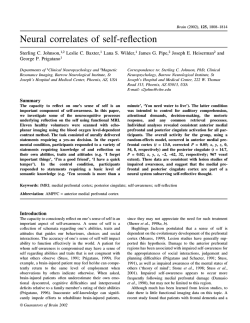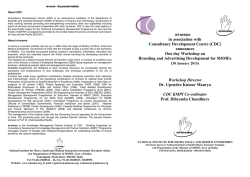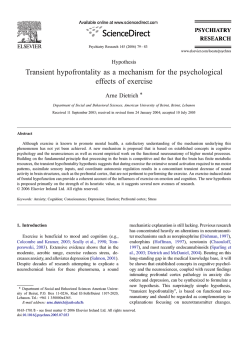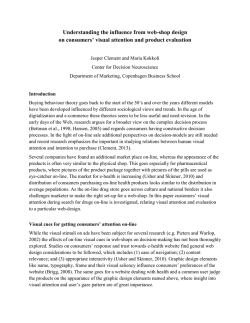
Regional brain activation wit
Journal of Neuroscience, Psychology, and Economics 2011, Vol. 4, No. 3, 147–160 © 2011 American Psychological Association 1937-321X/11/$12.00 DOI: 10.1037/a0024809 Regional Brain Activation With Advertising Images Ian A. Cook Clay Warren University of California, Los Angeles The George Washington University Sarah K. Pajot, David Schairer, and Andrew F. Leuchter University of California, Los Angeles Preferences for purchasing goods and services may be shaped by many factors, including advertisements presenting logical, persuasive information or those using images or text that may modify behavior without requiring conscious recognition of a message. We tested the hypothesis that these two types of messages (logical persuasion [LP] vs. nonrational influence [NI]) might affect brain function differently in a pilot project, using stimuli drawn from real-world print advertisements and quantitative electroencephalography as a noninvasive measure of regional brain activity. Twentyfour healthy subjects, 11 women and 13 men, viewed images while brain electrical activity was recorded. We used the low-resolution brain electromagnetic tomography method to quantify current intensity in brain regions implicated in decision-making and emotional processing. Data were analyzed using a block design to compare brain activity during LP and NI stimuli periods. LP images were associated with consistently and significantly higher activity levels in orbitofrontal, anterior cingulate, amygdala, and hippocampus regions than were NI images. These findings suggest that advertising images can evoke different levels of regional brain activity related to the use of LP and NI elements. Keywords: brain activation, advertising, persuasion, influence, EEG, source localization, unconscious processing Human behavior is affected by multiple factors, some of which are within the conscious awareness of the individual and others of which may fall outside of awareness until the factors are pointed out. A central tenet of commercial advertising is that an individual’s purchasing preferences can be affected so that one product or service is chosen over another. It is possible that this impact can take place within the context of an advertisement that presents logical, factual information that is rationally persuasive (logical persuasion, or LP); alternatively, an advertisement might use images or text that are perceived or processed outside of immediate awareness to shape behavior without reliance on rational evaluation (nonrational influence, or NI). Pratkanis and Greenwald (1988) suggested several routes of stimulus presentation that might be used to circumvent conscious awareness of the image and its message: subthreshold stimuli, which are presented at levels too weak to be consciously detected; masked stimuli, Ian A. Cook, Sarah K. Pajot, David Schairer, and Andrew F. Leuchter, Laboratory of Brain, Behavior, and Pharmacology, Semel Institute for Neuroscience and Human Behavior, and Brain Research Institute, University of California, Los Angeles; Clay Warren, Department of Organizational Sciences and Communication, The George Washington University. We acknowledge financial support for this project from the International Consciousness Research Laboratories consortium (http://www.icrl.org). We thank Barbara Siegman and Suzie Hodgkin (for recording the electroencephalograph data); Michelle Abrams (for subject recruitment and evaluation); Melinda Morgan and Jodie Cohen (for data management); and Robert Jahn, Brenda Dunne, and the late Michael Witunski (for informative discussions in developing and executing this investigation). Correspondence concerning this article should be addressed to Ian A. Cook, Miller Family Professor of Psychiatry and Biobehavioral Sciences, Semel Institute for Neuroscience and Human Behavior, University of California, Los Angeles, CA 90024-1759, or to Clay Warren, Chauncey M. Depew Professor of Communication, Department of Organizational Sciences and Communication, The George Washington University, Washington, DC 20052-0048. E-mail: [email protected] or [email protected] 147 148 COOK, WARREN, PAJOT, SCHAIRER, AND LEUCHTER which are hidden from awareness by overriding stimuli; unattended stimuli, which are presented in a context to avoid conscious decoding of the images or their meaning; and figurally transformed stimuli, using words or pictures that have been distorted to a point of conscious unrecognizability. Regardless of the technique used, stimuli presented outside of conscious awareness are hypothesized to include images that might manipulate the viewer by affecting autonomic arousal or emotional state and could include elements considered provocative in nature. Bargh (2002) broadened considerations from a focus on affecting hedonic-driven behaviors to the possibility that an impact on any kind of goal or motivation might be achieved outside of awareness. Decision-Making Systems and the Brain The possibility of two separate human decision-making processes has been widely discussed by Schneider and Shiffrin (1977), Sloman (1996, 2002), Kahneman (2003), Evans (2003), and others. Stanovich and West (2000) codified these two processes into System 1 (characterized as intuitive, fast, parallel, automatic, effortless, associative, emotional) and System 2 (reasoning, slow, serial, controlled, effortful, rule governed, neutral). As an illustration in the advertising context, an LP-type advertisement (appealing to System 2 processing) might show the product clearly and convey factual, descriptive data (“best mileage in its class,” “top rated”). In contrast, an NI-type advertisement (targeting System 1) might minimize the use of text and instead incorporate elements into the image that could be considered to be sexually evocative by some viewers (e.g., breast- or phallic-shaped elements). Thoughtful reviews of this controversial area in communication include those by Theus (1994), Trappey (1996), Merikle and Daneman (1998), Shapiro (1999), and Aylesworth, Goodstein, and Kaira (1999), with most investigators finding some evidence indicating the presence of these elements in print advertisements (cf. Warren, 2009). Although a considerable body of work has examined the neurobiological substrates of decision making in the neuroeconomics context (see reviews by Camerer, Loewenstein, & Prelec, 2005, and Goel, 2007), the impact on brain function of the presence or absence of these particular elements in realworld advertisements is not well characterized, despite the considerable attention surrounding the notion of neuromarketing (reviewed by Lee, Broderick, & Chamberlain, 2007, and Plassman, Ambler, Braeutigam, & Kenning, 2007). Neuroimaging, Perception, and Assessment Much of the experimental research that has been performed has focused on processing of facial images. Using facial and nonfacial images, although not from advertisements, Hoshiyama, Kakigi, Watanabe, Miki, and Takeshima (2003) found different brain responses with electroencephalography (EEG) and magnetoencephalography methods, even when the presentation was below the level of conscious awareness. Lehmann et al. (2004) reported a dissociation between overt and unconscious processing of facial recognition in the fusiform area. Pessoa (2005) observed that processing of emotional information is prioritized by the brain and does not require the emotional information to be the focus of conscious attention. Using backward masking, Whalen et al. (1998) observed a larger magnitude of brain response to fearful faces than to happy faces, even though subjects did not recall seeing any emotionally expressive faces at all. Kilgore and YurgelenTodd (2004) reported that happy and sad faces elicited different activations in the anterior cingulate and amygdala with a backward masking paradigm. Dijksterhuis (2004), Dijksterhuis, Bos, Nordgren, and van Baaren, (2006), and Dijksterhuis and Aarts (2010) have reviewed and synthesized primary studies suggesting that considerable amounts of processing and decision making may take place outside of conscious awareness. Klucharev, Smidts, and Ferna´ndez (2008) reported that seeing an image of a product soon after that of a celebrity with perceived expertise about the product influenced activation in hippocampus, anterior cingulate, caudate, fusiform gyrus, superior frontal gyrus, and other connected regions, as well as recall of images a day later. Measuring Brain Reactions to Actual Advertisements Neuroimaging methods (cf. Raichle & Mintun, 2006) hold various degrees of potential for studying how the brain reacts to advertisements. REGIONAL BRAIN ACTIVATION WITH ADVERTISING IMAGES Positron emission tomography (PET) can be used to visualize regional metabolism or blood flow as an indirect indicator of neuronal processing. Metabolic PET scans yield an aggregate of activity patterns averaged over the tens of minutes required for radioactive tracer uptake, a time frame ill suited to studying viewing advertisements that are normally seen only briefly, whereas perfusion PET scans, operating on a time scale of tens of seconds, have dosimetry limitations of radiation exposure that would limit an experiment to only a few stimuli. Functional MRI (FMRI) can be used to study changes in regional blood oxygenation levels reflective of local brain activity, with changes in stimuli on the order of a few seconds. EEG affords a noninvasive, unobtrusive, nonradioactive approach to studying the primary neuronal, synaptic events as the brain processes information, which secondarily give rise to changes in blood flow or metabolism. Most work with EEG and processing of visual images has relied on comparisons of patterns of scalp electrical fields, either as an event-related or an evoked response (cf. Vuilleumier & Pourtois, 2007), including some work with EEG and advertisements (e.g., Ohme, Reykowska, Weiner, & Choromanska, 2009; S. Weinstein, Appel, & Weinstein, 1980; or W. Weinstein, Drozdenko, & Weinstein, 1984). A central challenge has been to use the temporal resolution of EEG while overcoming the spatial resolution limitations of surface analyses. The introduction of three-dimensional current density models, for example with the low-resolution brain electromagnetic tomography (LORETA) approach (Pascual-Marqui et al., 1999; Pascual-Marqui, Michel, & Lehmann, 1994), has advanced studies of brain activity of deep structures as well as those near the brain’s surface. Current density assessments have not previously been applied to neuropsychoeconomic investigations. Given the findings with standardized stimuli reported by others, we hypothesized that patterns of regional brain function would differ when subjects viewed logical persuasion versus nonrational influence images drawn from actual print advertisements used in commerce. We tested this hypothesis by measuring brain electrical activity as advertisements were presented visually and then using standard methods to determine the current density patterns in key brain regions implicated in the process- 149 ing of this information. In the process, we also evaluated the feasibility of using source localization methods to advance neuropsychoeconomic research. Method Experimental Design To examine patterns of regional brain activity under conditions of viewing advertising images, we collected quantitative EEG data using a conventional stimulus-activation protocol. The protocol of viewing these images was included as a task in a larger set of activations and rest periods during EEG recording in a project studying brain function and structure in healthy aging, and it was reviewed and approved by the University of California, Los Angeles, Institutional Review Board. Informed consent was obtained from all subjects in advance of experimental procedures, in accordance with the Declaration of Helsinki. Subjects were informed that these experimental procedures were being used to evaluate brain processing of visual images and that they should strive to remember the images. EEG was selected as a noninvasive, welltolerated method to assess brain activity at rest and during activation procedures. Participants Data were collected from 24 healthy volunteers who were part of the project studying healthy aging. All were in good health at the time of enrollment and had a normal neurological and psychiatric examination. Exclusion criteria included any active or past history of an Axis I major psychiatric disorder (e.g., manic depression, schizophrenia, Alzheimer’s disease); any poorly controlled medical illness that could affect brain function (e.g., untreated hypothyroidism); concurrent use of central nervous system–active medications that could interfere with EEG activity (e.g., benzodiazepines); current or past drug or alcohol abuse; and any history of head trauma, brain surgery, skull defect, stroke or transient ischemic attacks or evidence of stroke on previous MRI. Subjects were 11 women and 13 men. The mean age for all 24 subjects was 77.2 years (SD ϭ 10.6 years). They had a mean of 16.3 years (SD ϭ 2.8) of education; 1 man and 2 women 150 COOK, WARREN, PAJOT, SCHAIRER, AND LEUCHTER were left handed. Men and women did not differ statistically on age, handedness, or years of education. Procedures Advertising images. We assessed brain activity in each of three conditions: (a) resting, awake state, with eyes closed; (b) viewing stimuli categorized as LP images; and (c) viewing stimuli that were NI images. Twenty-four images were used as stimuli; all were actual advertisements that appeared in magazines, newspapers, and similar commercial print media. Some example images are shown in Figure 1. The sample LP-type advertisements (upper row) present (a) a table of facts and figures about cigarette products, (b) the details about how to build a better toothbrush, (c) information and the question “Which makes more sense?” concerning a curved versus a straight tampon product, and (d) suggestions about selecting food for dogs on the basis of their activity level. In contrast, sample NI-type advertisements (lower row) show (e) water beading on a road surface with a shape suggesting the outline of a dead body, (f) an overlay image combining a woman standing with legs apart and a statue’s royal scepter positioned in her groin, (g) a woman leapfrogging over a fire hydrant erupting with a water spray as a man enthusiastically grins behind her, and (h) a big dog measuring the length of his sausage-shaped dog food at 7 in. on a measuring tape. The selection of ads followed not only the System 1–System 2 decision-making codification previously mentioned, it also reflects a conventional application of Aristotelian-defined persuasion-based influence (still used after more than 2,000 years) that, by definition, must be intended by the source to allow choice for the receiver through the presentation of a claim with a direct connection to a product or an idea—a claim open to the use of verifiable evidence and appropriate reasoning (Aristotle, 2009; Warren, 2010). NI, however, involves data intended by the source to circumvent evidential reasoning and thus allow a receiver little to no choice, preferably the latter, usually based on a claim with no direct connection (or a Figure 1. Example advertisements. Samples of logical persuasion (upper row, a– d) and nonrational influence (lower row, e– h) advertisements are shown. REGIONAL BRAIN ACTIVATION WITH ADVERTISING IMAGES connection the source would be unwilling to verbally identify) to a product or an idea. (Various types of NI have been the subject of vigorous discussion to date; see Warren, 2009, for a summary review of this area.) All of the LP and NI ads selected for use in this study fit these fundamental definitional criteria. The four example LP ads (see Figure 1) establish a claim directly connected to the product; the four example NI ads, purposely open to individual interpretation, rely on provocative elements that have no direct connection to the ad’s claim. Specifically, this project’s experimental stimuli were selected from more than 20 years of collected example advertisements drawn from our research and teaching files. A panel of three faculty members with expertise in public communication established a consensus of typing for this collection with a high interrater reliability (Cronbach’s ␣ ϭ .92). The subset of 24 images used for this study was culled from the larger set (several hundred ads) as reasonable exemplars of LP and NI advertising, recognizing that real-world ads are not exclusively LP or NI in nature. We purposely selected the option of using actual ads for this preliminary study to establish a baseline: If receivers’ processing of ecologically valid images did not yield a detectable difference in current density, the viability of this approach for future studies could not be examined. Because media ads have historically been “shotgunned” to a broad and heterogeneous audience, there was no reason to select ads on the basis of user groups and to prematurely attempt to segment this inquiry (e.g., using ads only with their intended customers). In fact, given the preliminary nature of this feasibility study, circumscribing receivers by unwarrantedly tight boundaries at this point could promote statistically sophisticated answers that bypass the general problem: Premature definitional precision can flatten unique, possibly determinant, patterns into general, potentially irrelevant, relational theory (see Cocker, 1983). Advertising image activation. Advertisements were scanned from their original print format and shown at their original dimensions on the computer screen, except for two images (size rescaled from full magazine page to fit on the computer screen). Because we sought to study the effects of real advertisements by simulating the actual viewing experience, we did 151 not make any adjustments to the brightness, contrast, or color balance of the images, because these manipulations would have an adverse impact on the ecologic validity of the stimuli and limit our ability to test hypotheses about the impact on brain activity of actual advertisements. Stimuli were presented serially using a block design: 6 LP 3 6 NI 3 6 LP 3 6 NI. Each stimulus was presented via computer screen for 20 s (SuperLab; Cedrus Corp., San Pedro, CA) at a viewing distance of 15–26 cm and without any delay between stimuli. Data recorded during the 12 LP stimuli presentations were averaged for each individual, as were the data for the 12 NI stimuli. Segments contaminated by excessive artifact (e.g., muscle-related or eye-motion artifacts) were excluded from analysis. The resting awake state was assessed at the start of the recording session, before any activations took place. Before presentation of the stimuli, subjects were instructed to look at and remember each image; no overt response was required. EEG Methods Recordings were performed using standard procedures and equipment previously detailed (Cook et al., 2002; Cook, O’Hara, Uijtdehaage, Mandelkern, & Leuchter, 1998; Leuchter, Uijtdehaage, Cook, O’Hara, & Mandelkern, 1999) in a sound-attenuated room. To sustain the awake state during the resting eyes-closed condition, subjects were alerted by the technicians during these periods with prompts at the emergence of any sign of drowsiness (e.g., tapping a pen to make a percussive sound). A Pzreferential montage was used to collect data from 35 scalp recording electrodes, placed with a custom electrode cap (ElectroCap, Eaton, OH) using a standard extension of the international 10 –20 system (see Figure 2). Signals were digitally recorded with the QND system (Neurodata, Inc., Pasadena, CA), using a passband of 0.3–70 Hz. This system allowed for offline reformatting of data after the recording to determine power values relative to a linked-ears reference. Data were analyzed at a sample rate of 256 samples per second for each channel, using segments of data of 2-s duration (512 points). EEG data segments were selected if they were free of eye blink, muscle, or drowsiness artifacts. 152 COOK, WARREN, PAJOT, SCHAIRER, AND LEUCHTER Figure 2. Electrode montage. We used a standard extension of the international 10 –20 system to sample surface electrical activity across all brain regions. These segments of EEG activity were then processed by the LORETA method (PascualMarqui et al., 1999; Pascual-Marqui et al., 1994). This numerical method reconstructs the three-dimensional configuration of current sources that could give rise to the measured surface EEG signals. Critically, cross-modal validation has been performed, finding agreement between LORETA and more established measures of regional brain activity with FMRI (Mulert et al., 2004; Vitacco, Brandeis, PascualMarqui, & Martin, 2002) and PET (Dierks et al., 2000; Oakes et al., 2004). This source localization technique has been paired with taskactivation paradigms by other researchers to examine patterns of regional brain activity during engagement in particular mental tasks (e.g., Hanslmayr et al., 2008; Lavric, Pizzagalli, & Forstmeier, 2004; Pizzagalli, Sherwood, Henriques, & Davidson, 2005; Santesso et al., 2008). LORETA yields current values in 2,394 voxels (Pascual-Marqui et al., 1994) in six standard frequency bands. We combined voxels to compute average current density values (amp/ m2) for specific a priori regions of interest (ROIs) and then averaged LP and NI stimuli separately to achieve an estimate of current density for each ROI in each condition. To define our ROIs, we used the LORETA package’s correspondence between named region, Brodmann area (BA), and Tailarach coordinates: orbitofrontal cortex (OFC, comprising BAs 10 and 11), dorsolateral prefrontal cortex (DLPFC; BAs 44, 45, and 46), anterior cingulate cortex (ACC; BAs 24, 25, 32, and 33), amygdala (AMY), and hippocampus (HIP). These regions were included because prior work has implicated them in regulating decision making and processing of emotional information (cf. Barrett & Wager, 2006; Davidson, Jackson, & Kalin, 2000; Gruber, Rogowska, & Yurgelun-Todd, 2004; Killgore & Yurgelun-Todd, REGIONAL BRAIN ACTIVATION WITH ADVERTISING IMAGES 2004, Phan, Wager, Taylor, & Liberzon, 2002; Scheinle & Schafer, 2009; Seitz, Franz, & Azari, 2009). The somatosensory cortex (SS; BAs 3, 1, 2) was used as a control region that we predicted would not show significant differences in activity related to stimulus type. Additionally, we focused on delta (1– 6.5 Hz) and beta-3 (21.5–31 Hz) bands, because prior work has demonstrated a positive correlation between regional cerebral perfusion and EEG activity in those frequency ranges (Cook et al., 1998; Leuchter et al., 1999). Data Analysis Analyses were performed using the PASW statistical package (SPSS, Inc., Chicago, IL). Continuous variable data were analyzed with t tests; categorical data were examined using the chi-square statistic. Results Using the entire sample, we found significant differences in multiple brain regions. Higher activity was detected during LP than NI images bilaterally in OFC and ACC (Table 1 and 153 Figure 3; p Ͻ .05). Current density was also higher during LP than NI images in right-sided AMY and HIP, but not left sided (nonsignificant difference). Activity in the DLPFC did not differ significantly between LP and NI images in either hemisphere. Additionally, our SS control region did not show significant differences between stimulus types in either hemisphere. In no ROI was the current density observed to be significantly higher during NI images than during LP images. To examine whether there might be genderrelated differences in regional current density values, we compared average values in each ROI between male and female subjects. No significant differences were detected between the two groups. To examine the potential effects of handedness, we reexamined the average current density values in each ROI for only righthanded subjects (n ϭ 21); the regions showing significant differences between LP and NI images were generally similar to the entire group (see Table 2), although some areas were no longer statistically significant with the smaller sample size. Table 1 Patterns of Regional Activation Regions of interest (M ͓SD͔) Band Delta Left hemisphere LP NI t Right hemisphere LP NI t Beta-3 Left hemisphere LP NI t Right hemisphere LP NI t SS OFC ACC DLPFC AMY HIP 3.49 (1.92) 2.87 (1.77) 1.52 8.34 (9.38) 5.12 (3.40) 2.15ءء 3.19 (3.38) 1.80 (1.01) 2.44ءء 3.26 (2.84) 2.52 (1.45) 1.39 2.69 (1.53) 2.15 (1.14) 1.65 1.85 (1.58) 1.42 (1.43) 1.41 3.31 (2.35) 2.95 (2.31) 1.35 8.10 (8.68) 5.06 (3.79) 2.24ءء 3.28 (3.47) 1.85 (1.05) 2.47ءء 3.93 (2.80) 3.09 (2.01) 1.66 2.92 (2.03) 2.40 (1.90) 1.80ء 1.46 (1.14) 1.04 (0.57) 1.88ء 9.83 (4.77) 8.92 (4.32) 1.57 20.96 (19.47) 15.93 (8.85) 1.71 7.70 (6.30) 5.51 (2.57) 2.07ءء 10.39 (7.39) 9.60 (5.30) 0.83 7.27 (3.46) 6.89 (3.29) 0.40 3.33 (2.12) 2.79 (1.31) 1.60 10.77 (7.00) 10.37 (7.41) 0.78 21.36 (18.15) 16.69 (10.03) 1.79ء 7.95 (6.51) 5.67 (2.64) 2.08ءء 15.26 (14.00) 14.80 (16.40) 0.37 8.38 (5.50) 9.04 (6.31) Ϫ0.44 4.67 (3.82) 4.14 (3.50) 1.11 Note. ACC ϭ anterior cingulate cortex; AMY ϭ amygdala; DLPFC ϭ dorsolateral prefrontal cortex; HIP ϭ hippocampus; OFC ϭ orbitofrontal cortex; SS ϭ somatosensory region. ء p Ͻ .5. ءءp Ͻ .025. 154 COOK, WARREN, PAJOT, SCHAIRER, AND LEUCHTER Figure 3. Differences in activity between conditions. Regional current density values are shown for delta and beta-3 frequency bands across our regions of interest: left (L) and right (R) SS, OFC, ACC, DLPFC, AMY, and HIP. ACC ϭ anterior cingulate cortex; AMY ϭ amygdala; DLPFC ϭ dorsolateral prefrontal cortex; HIP ϭ hippocampus; OFC ϭ orbitofrontal cortex; SS ϭ somatosensory region. t tests were used. ءp Ͻ .05. ءءp Ͻ .025. Discussion In this pilot project, we had hypothesized that LP and NI images would elicit different patterns of brain activation, and we found that differences in OFC, ACC, AMY, and HIP were detectable using the LORETA three-dimensional current source localization technique. In all these brain regions, viewing of LP stimuli was consistently associated with higher levels of current than was viewing of NI stimuli. We believe that this study is the first using EEG to find sup- port for differential neurophysiologic activity elicited by these two types of real-world advertising images in deep and cortical brain regions. LP images consistently resulted in higher activity in delta and beta-3 bands than NI images; because this is a pilot feasibility project rather than a definitive study, we can offer only modest, although potentially important, speculations on the possible meaning of these findings. The ACC region is a central component of the limbic system and is believed to play a role not only in emotional processing but also in select- Table 2 Comparison of Regional Activation Based on Handedness Region of interest Band Delta L all L RH R all R RH Beta-3 L all L RH R all R RH SS OFC ACC DLPFC AMY HIP 1.52 1.03 1.35 0.80 2.15ءء 2.35ءء 2.24ءء 2.69ءءء 2.44ءء 2.17ءء 2.47ءء 2.21ءء 1.39 0.83 1.66 1.22 1.65 1.11 1.80ء 1.30 1.41 0.96 1.88ء 1.44 1.57 1.12 0.78 0.28 1.71 1.47 1.79ء 1.52 2.07ءء 1.77ء 2.08ءء 1.77ء 0.83 Ϫ0.08 0.37 Ϫ0.38 0.40 0.57 Ϫ0.44 Ϫ0.17 1.60 1.13 1.11 0.63 Note. The t scores from all 24 participants (all) are tabulated with those from the 21 right-handed participants (RH) in delta and beta-3 bands for each of our a priori regions of interest. ACC ϭ anterior cingulate cortex; AMY ϭ amygdala; DLPFC ϭ dorsolateral prefrontal cortex; HIP ϭ hippocampus; L ϭ left hemisphere; OFC ϭ orbitofrontal cortex; R ϭ right hemisphere; SS ϭ somatosensory region. ء p Ͻ .5. ءءp Ͻ .025. ءءءp Ͻ .01. REGIONAL BRAIN ACTIVATION WITH ADVERTISING IMAGES ing which stimulus merits a response in the face of competing streams of information (cf. Bush, Luu, & Posner, 2000; Kennerley, Walton, Behrens, Buckley, & Rushworth, 2006; Pardo, Pardo, Janer, & Raichle, 1990). The higher ACC currents we found during LP stimuli could be interpreted as being consistent with greater processing needs for the factual information presented in LP ads. With PET perfusion methods, Stole´ru et al. (2003) reported activation in a portion of the ACC (BA 24) in both healthy adult men and men with hypoactive sexual desire disorder when they watched visual sexual stimuli, in which sexual activity was the focus of the images. Anatomical subdivisions of the ACC have been found to subserve different functions (cf. Carter & van Veen, 2007; Devinsky, Morrell, & Vogt, 1995), which could include differences in assessing the salience of primary versus secondary aspects of content. The OFC is also critically involved in evaluating the emotional (reward) salience of stimuli from a variety of sensory inputs (e.g., Rolls & Grabenhorst, 2008). Given that the OFC is implicated in inhibiting responses to stimuli (cf. Chiu, Holmes, & Pizzagalli, 2008; Dillon & Pizzagalli, 2007; Hodgson et al., 2002), the lower activity associated with NI images could be consistent with lesser degrees of behavioral inhibition during exposure to those stimuli, potentially leading to patterns of less restrained behaviors in connection with products depicted in the NI advertisements. The AMY serves key roles in emotional processing and vigilance (cf. Davis & Whalen, 2001) and may modulate the activity in other brain regions in response to emotional stimuli (Vuilleumier & Pourtois, 2007). The rightlateralized AMY activation we found is suggestive of nonverbal processing in that hemisphere in right-handed subjects (cf. Gazzaniga, 2000; Lindell, 2006). This pattern was present in the right-handed subjects in our pool, and although we enrolled both right- and left-handed adults in our project, a future study might focus on enrollment of subjects of a single handedness or expand enrollment to have adequate statistical power to detect handedness-based differences. Our AMY finding is consistent with previous reports of the right AMY’s role in affective information processing of pictorial or imagerelated material (Markowitsch, 1998). 155 The HIP is central to the formation of declarative memories that can be explicitly verbalized (cf. Squire, 1992), so our higher current values during LP stimuli suggest that LP advertisements may engage declarative learning more than the NI images, which either are not explicitly memorable or, alternatively, might be remembered via nondeclarative mechanisms not involving hippocampal recruitment. We did not test subjects at the end of the experiment for their ability to recall advertisements they had previously viewed, so we cannot test this conjecture. The failure to find differences in DLPFC activity in our data may reflect smaller differences in emotional valence of the stimulus categories than anticipated (cf. Simpson et al., 2000) or a lack of engagement of this particular emotional processing center in evaluating advertising images. The lack of differential activation in the SS region supports the conclusion that there is not simply a generalized increase in activity with LP stimuli across all brain regions, but rather that the differences have regional specificity. Morris et al. (2009) examined brain activation while subjects watched TV advertisements during FMRI scanning and then rated ads along dimensional constructs of “pleasure” and “arousal.” They found that bilateral activations in the inferior frontal and middle temporal gyri were associated with differences along the pleasure dimension, whereas the arousal dimension influenced activation in right superior temporal and right middle frontal gyri. Our study’s findings are consistent with Morris et al.’s conclusion that the differing emotional reactions to viewing ads may be related to underlying neurobiological processes, but further direct comparisons are difficult given differences in the two studies’ stimuli and hypotheses. In another project, Ohme et al. (2009) used EEG, electromyography, and skin conductance to study subjects as they watched two versions of a TV advertisement that differed only in the visual image presented in a single scene. They had hypothesized that the two versions would produce different levels of asymmetric EEG activation in the frontal regions, based on the approach– avoidance model proposed by Davidson (2004), as well as differing levels of arousal detected via skin conductance and electromyography activity. They found statistical 156 COOK, WARREN, PAJOT, SCHAIRER, AND LEUCHTER differences in their surface asymmetry measure in comparing the two versions of the scene, even though subjects did not consciously recall seeing a difference in the two video clips; skin conductance and electromyography activity also differed. A direct comparison of our three-dimensional regional findings with their asymmetry measure is difficult to make, but both sets of findings indicate that neurophysiologic activity may differ when advertisements are viewed, even if subjects have no conscious recall of differences in the information presented. Limitations and Future Directions to Address Them We should note several limitations of this study, along with their implications for future research. One is whether the observed differences are tied to the particular stimuli in our battery or if this is a more general phenomenon. Our choice of actual advertisements is both a strength and a limitation of this project; although our observations have an ecological validity that is not possible with images contrived to control for features such as amounts of text, luminance, or saturation of color, we are limited in our ability to identify which components of the images may have driven the differences in regional brain activation. Future extensions could address this concern by using a wider variety of stimuli drawn from sources not confined to realworld advertisements, such as synthetic images designed to directly test hypotheses about how the brain evaluates information presented without engaging logical awareness, or images that vary the degree of emotional charge. Future work might include the development and validation of a standardized set of advertising stimuli much like the widely used Pictures of Facial Affect stimuli developed by Ekman and Friesen (1976); such a set would strive to have wellcharacterized psychometric (e.g., emotional valence and arousal) or physical (e.g., luminance, word count) properties. We also did not seek to study whether one type of advertisement was superior to the other; we elicited no data on recall of or attitudes toward the products being advertised, and no conclusions as to merit of advertising strategy should be drawn from this study. Another limitation is that our subjects were older adults. It has been reported that younger and older individuals may use different strategies when processing images (detail processing vs. schema-based processing, per Yoon, 1997) or emotional information (e.g., Kensinger & Leclerc, 2009). The emotional valence of some of the NI elements in the stimuli might be different in younger subjects, and future studies could address this by enrolling subjects across a wider range of ages or by explicitly comparing a group of subjects in their 20s with a group such as our subject pool. An additional consideration related to our subject pool is that it contained similar numbers of male and female subjects. Some evidence from prior work has shown that gender-related differences may exist in information processing (e.g., Orozco & Ehlers, 1998), and future studies might seek to focus on a single gender or might be larger so as to have adequate statistical power to detect gender-related differences. An additional line of work might evaluate whether processing differences emerged in comparison of individuals with personal relevance to the product or not (e.g., gender- or lifestyle-specific products). Another potential criticism is that our instruction to the subjects—to try to remember the images—is not how advertisements in magazines and other print media are conventionally viewed. Although advertisers may hope that their advertisements will be remembered, there is, of course, no such instruction given as a person is exposed to these images in daily life; future work might examine differences between an instructionless viewing period and different sorts of structured, specific instructions, because these might alter the subjects’ approach to viewing and processing. Finally, our data do not allow us to differentiate between specific attributes of the NI stimuli, which might include impact on either emotional or unconscious processes. Indeed, advertisements of this NI variety appear to frequently blend the two, and disambiguation might be better addressed using images chosen or artificially constructed to separate these elements. Future work in this area might include the development of a standardized battery of advertisements with well-characterized psychometric properties. REGIONAL BRAIN ACTIVATION WITH ADVERTISING IMAGES Conclusions and Implications for Psychology, Communication, Economics, and Business These pilot data provide evidence for differences in regional brain processing of real-world advertising images, depending on whether the images appeal to rational, logical functions or to nonrational, emotionally valenced functions. Our findings may raise numerous new questions, as our earlier recommendations for future work suggest. Nonetheless, such future work cannot be justified without pilot investigations, such as this one, that demonstrate the feasibility of using these measures in this novel way. For research in psychology and communication, these findings provide additional justification for studying decision-making processes through the use of inductively generated evidence. For economics and business, our findings lend support to the possibility that some elements of decision making may be influenced by appeals outside of a rational evaluation of information. Given that economic theories tend to be predicated on a rational appraisal of information being the determinant of actions, our findings suggest that consideration of more inclusive theories may be warranted. For business, our findings suggest that further study is needed before reliable predictions, based on neurophysiologic measurements, can be advanced about how advertising campaigns sway consumer behavior. Overall, additional work is both necessary and warranted to help bridge from these initial neurophysiologic observations to implications for advertising practices and behavioral influences in human consumers. References Aristotle. (2009). Rhetoric (W. R. Roberts, Trans.). Whitefish, MT: Kessinger. Aylesworth, A. B., Goodstein, R. C., & Kaira, A. (1999). Effect of archetypal embeds on feelings: An indirect route to affecting attitudes? Journal of Advertising, 28, 73– 81. Bargh, J. A. (2002). Losing consciousness: Automatic influences on consumer judgment, behavior, and motivation. Journal of Consumer Research, 29, 280 –285. Barrett, L. F., & Wager, T. D. (2006). The structure of emotion: Evidence from neuroimaging studies. Current Directions in Psychological Science, 15, 79 – 83. 157 Bush, G., Luu, P., & Posner, M. I. (2000). Cognitive and emotional influences in anterior cingulate cortex. Trends in Cognitive Sciences, 4, 215–222. Camerer, C., Loewenstein, G., & Prelec, D. (2005). Neuroeconomics: How neuroscience can inform economics. Journal of Economic Literature, 43, 9 – 64. Carter, C. S., & van Veen, V. (2007). Anterior cingulate cortex and conflict detection: An update of theory and data. Cognitive, Affective, and Behavioral Neuroscience, 7, 367–379. Chiu, P. H., Holmes, A. J., & Pizzagalli, D. A. (2008). Dissociable recruitment of rostral anterior cingulate and inferior frontal cortex in emotional response inhibition. NeuroImage, 42, 988 –997. Cocker, J. (1983). Can we measure social relationships? New Scientist, 97, 793–796. Cook, I. A., Leuchter, A. F., Morgan, M., Witte, E., Stubbeman, W. F., Abrams, M., . . . Uijtdehaage, S. H. (2002). Early changes in prefrontal activity characterize clinical responders to antidepressants. Neuropsychopharmacology, 27, 120 –131. Cook, I. A., O’Hara, R., Uijtdehaage, S. H. J., Mandelkern, M., & Leuchter, A. F. (1998). Assessing the accuracy of topographic EEG mapping for determining local brain function. Electroencephalography and Clinical Neurophysiology, 107, 408 – 414. Davidson, R. J. (2004). What does the prefrontal cortex “do” in affect? Perspectives on frontal EEG asymmetry research. Biological Psychology, 67, 219 –233. Davidson, R. J., Jackson, D. C., & Kalin, N. H. (2000). Emotion, plasticity, context, and regulation: Perspectives from affective neuroscience. Psychological Bulletin, 126, 890 –909. Davis, M., & Whalen, P. J. (2001). The amygdala: Vigilance and emotion. Molecular Psychiatry, 6, 13–34. Devinsky, O., Morrell, M. J., & Vogt, B. A. (1995). Contributions of anterior cingulate cortex to behaviour. Brain, 118(Pt. 1), 279 –306. Dierks, T., Jelic, V., Pascual-Marqui, R. D., Wahlund, L., Julin, P., Linden, D. E., . . . Nordberg, A. (2000). Spatial pattern of cerebral glucose metabolism (PET) correlates with localization of intracerebral EEG-generators in Alzheimer’s disease. Clinical Neurophysiology, 111, 1817–1824. Dijksterhuis, A. (2004). Think different: The merits of unconscious thought in preference development and decision making. Journal of Personality and Social Psychology, 87, 586 –598. Dijksterhuis, A., & Aarts, H. (2010). Goals, attention, and (un)consciousness. Annual Review of Psychology, 61, 467– 490. Dijksterhuis, A., Bos, M. W., Nordgren, L. F., & van Baaren, R. B. (2006). On making the right choice: 158 COOK, WARREN, PAJOT, SCHAIRER, AND LEUCHTER The deliberation-without-attention effect. Science, 311, 1005–1007. Dillon, D. G., & Pizzagalli, D. A. (2007). Inhibition of action, thought, and emotion: A selective neurobiological review. Applied and Preventive Psychology, 12, 99 –114. Ekman, P., & Friesen, W. V. (1976). Pictures of facial affect. Palo Alto, CA: Consulting Psychologists Press. Evans, J. S. (2003). In two minds: Dual-process accounts of reasoning. Trends in Cognitive Sciences, 7, 454 – 459. Gazzaniga, M. S. (2000). Cerebral specialization and interhemispheric communication: Does the corpus callosum enable the human condition? Brain, 123(Pt. 7), 1293–1326. Goel, V. (2007). Anatomy of deductive reasoning. Trends in Cognitive Sciences, 11, 435– 441. Gruber, S. A., Rogowska, J., & Yurgelun-Todd, D. A. (2004). Decreased activation of the anterior cingulate in bipolar patients: An fMRI study. Journal of Affective Disorders, 82, 191–201. Hanslmayr, S., Pasto¨tter, B., Ba¨uml, K. H., Gruber, S., Wimber, M., & Klimesch, W. (2008). The electrophysiological dynamics of interference during the Stroop task. Journal of Cognitive Neuroscience, 20, 215–225. Hodgson, T. L., Mort, D., Chamberlain, M. M., Hutton, S. B., O’Neill, K. S., & Kennard, C. (2002). Orbitofrontal cortex mediates inhibition of return. Neuropsychologia, 40, 1891–1901. Hoshiyama, M., Kakigi, R., Watanabe, S., Miki, K., & Takeshima, Y. (2003). Brain responses for the subconscious recognition of faces. Neuroscience Research, 46, 435– 442. Kahneman, D. (2003). Maps of bounded rationality: Psychology for behavioral economics. American Economic Review, 93, 1449 –1475. Kennerley, S. W., Walton, M. E., Behrens, T. E., Buckley, M. J., & Rushworth, M. F. (2006). Optimal decision making and the anterior cingulate cortex. Nature Neuroscience, 9, 940 –947. Kensinger, E. A., & Leclerc, C. M. (2009). Agerelated changes in the neural mechanisms supporting emotion processing and emotional memory. European Journal of Cognitive Psychology, 21, 192–215. Killgore, W. D., & Yurgelun-Todd, D. A. (2004). Activation of the amygdala and anterior cingulate during nonconscious processing of sad versus happy faces. NeuroImage, 21, 1215–1223. Klucharev, V., Smidts, A., & Ferna´ndez, G. (2008). Brain mechanisms of persuasion: How “expert power” modulates memory and attitudes. Cognitive, Affective, and Behavioral Neuroscience, 3, 353–366. Lavric, A., Pizzagalli, D. A., & Forstmeier, S. (2004). When “go” and “nogo” are equally frequent: ERP components and cortical tomography. European Journal of Neuroscience, 20, 2483–2488. Lee, N., Broderick, A. J., & Chamberlain, L. (2007). What is “neuromarketing”? A discussion and agenda for future research. International Journal of Psychophysiology, 63, 199 –204. Lehmann, C., Mueller, T., Federspiel, A., Hubl, D., Schroth, G., Huber, O., . . . Dierks, T. (2004). Dissociation between overt and unconscious face processing in fusiform face area. NeuroImage, 21, 75– 83. Leuchter, A. F., Uijtdehaage, S. H., Cook, I. A., O’Hara, R., & Mandelkern, M. (1999). Relationship between brain electrical activity and cortical perfusion in normal subjects. Psychiatry Research, 90, 125–140. Lindell, A. K. (2006). In your right mind: Right hemisphere contributions to language processing and production. Neuropsychology Review, 16, 131–148. Markowitsch, H. J. (1998). Differential contribution of right and left amygdala to affective information processing. Behavioural Neurology, 11, 233–244. Merikle, P. M., & Daneman, M. (1998). Psychological investigation of unconscious perception. Journal of Consciousness Studies, 5, 5–18. Morris, J. D., Klahr, N. J., Shen, F., Villegas, J., Wright, P., He, G., & Liu, Y. (2009). Mapping a multidimensional emotion in response to television commercials. Human Brain Mapping, 30, 789 – 796. Mulert, C., Ja¨ger, L., Schmitt, R., Bussfeld, P., Pogarell, O., Mo¨ller, H. J., . . . Hegerl, U. (2004). Integration of fMRI and simultaneous EEG: Towards a comprehensive understanding of localization and time-course of brain activity in target detection. NeuroImage, 22, 83–94. Oakes, T. R., Pizzagalli, D. A., Hendrick, A. M., Horras, K. A., Larson, C. L., Abercrombie, H. C., . . . Davidson, R. J. (2004). Functional coupling of simultaneous electrical and metabolic activity in the human brain. Human Brain Mapping, 21, 257– 270. Ohme, R., Reykowska, D., Weiner, D., & Choromanska, A. (2009). Analysis of neurophysiological reactions to advertising stimuli by means of EEG and galvanic skin response measures. Journal of Neuroscience, Psychology, and Economics, 2, 21–23. Orozco, S., & Ehlers, C. L. (1998). Gender differences in electrophysiological responses to facial stimuli. Biological Psychiatry, 44, 281–289. Pardo, J. V., Pardo, P., Janer, K., & Raichle, M. (1990). The anterior cingulate cortex mediates processing selection in the Stroop attentional conflict paradigm. Proceedings of the National Academy of Sciences, USA, 87, 256 –259. REGIONAL BRAIN ACTIVATION WITH ADVERTISING IMAGES Pascual-Marqui, R. D., Lehmann, D., Koenig, T., Kochi, K., Merlo, M. C., . . . Koukkou, M. (1999). Low resolution brain electromagnetic tomography (LORETA) functional imaging in acute, neuroleptic-naive, first-episode, productive schizophrenia. Psychiatry Research, 90, 169 –179. Pascual-Marqui, R. D., Michel, C. M., & Lehmann, D. (1994). Low resolution electromagnetic tomography: A new method for localizing electrical activity in the brain. International Journal of Psychophysiology, 18, 49 – 65. Pessoa, L. (2005). To what extent are emotional visual stimuli processed without attention and awareness? Current Opinion in Neurobiology, 15, 188 –196. Phan, K. L., Wager, T., Taylor, S. F., & Liberzon, I. (2002). Functional neuroanatomy of emotion: A meta-analysis of emotion activation studies in PET and fMRI. NeuroImage, 16, 331–348. Pizzagalli, D. A., Sherwood, R. J., Henriques, J. B., & Davidson, R. J. (2005). Frontal brain asymmetry and reward responsiveness: A source-localization study. Psychological Science, 16, 805– 813. Plassmann, H., Ambler, T., Braeutigam, S., & Kenning, P. (2007). What can advertisers learn from neuroscience? International Journal of Advertising, 26, 151–175. Pratkanis, A. R., & Greenwald, A. G. (1988). Recent perspectives on unconscious processing: Still no marketing applications. Psychology and Marketing, 5, 337–353. Raichle, M. E., & Mintun, M. A. (2006). Brain work and brain imaging. Annual Review of Neuroscience, 29, 449 – 476. Rolls, E. T., & Grabenhorst, F. (2008). The orbitofrontal cortex and beyond: From affect to decisionmaking. Progress in Neurobiology, 86, 216 –244. Santesso, D. L., Meuret, A. E., Hofmann, S. G., Mueller, E. M., Ratner, K. G., . . . Pizzagalli, D. A. (2008). Electrophysiological correlates of spatial orienting towards angry faces: A source localization study. Neuropsychologia, 46, 1338 –1348. Schienle, A., & Scha¨fer, A. (2009). In search of specificity: Functional MRI in the study of emotional experience. International Journal of Psychophysiology, 73, 22–26. Schneider, W., & Shiffrin, R. M. (1977). Controlled and automatic human information processing: I. Detection, search and attention. Psychological Review, 84, 1– 66. Seitz, R. J., Franz, M., & Azari, N. P. (2009). Value judgments and self-control of action: The role of the medial frontal cortex. Brain Research Reviews, 60, 368 –378. Shapiro, S. (1999). When an ad’s influence is beyond our conscious control: Perceptual and conceptual fluency effects caused by incidental ad exposure. Journal of Consumer Research, 26, 16 –36. 159 Simpson, J. R., Ongu¨r, D., Akbudak, E., Conturo, T. E., Ollinger, J. M., Snyder, A. Z., . . . Raichle, M. E. (2000). The emotional modulation of cognitive processing: An fMRI study. Journal of Cognitive Neuroscience, 12(Suppl. 2), 157–170. Sloman, S. A. (1996). The empirical case for two systems of reasoning. Psychological Bulletin, 119, 3–22. Sloman, S. A. (2002). Two systems of reasoning. In T. Gilovich, D. Griffin, & D. Kahneman (Eds.), Heuristics and biases: The psychology of intuitive thought (pp. 379 –396). New York, NY: Cambridge University Press. Squire, L. R. (1992). Memory and the hippocampus: A synthesis from findings with rats, monkeys, and humans. Psychological Review, 99, 195–231. Stanovich, K. E., & West, R. F. (2000). Individual differences in reasoning: Implications for the rationality debate? Behavioral and Brain Sciences, 23, 645– 665. Stole´ru, S., Redoute´, J., Costes, N., Lavenne, F., Bars, D. L., Dechaud, H., . . . Pujol, J. F. (2003). Brain processing of visual sexual stimuli in men with hypoactive sexual desire disorder. Psychiatry Research, 124, 67– 86. Theus, K. T. (1994). Subliminal advertising and the psychology of processing unconscious stimuli: A review of research. Psychology and Marketing, 11, 271–290. Trappey, C. (1996). A meta-analysis of consumer choice and subliminal advertising. Psychology and Marketing, 13, 517–530. Vitacco, D., Brandeis, D., Pascual-Marqui, R., & Martin, E. (2002). Correspondence of eventrelated potential tomography and functional magnetic resonance imaging during language processing. Human Brain Mapping, 17, 4 –12. Vuilleumier, P., & Pourtois, G. (2007). Distributed and interactive brain mechanisms during emotion face perception: Evidence from functional neuroimaging. Neuropsychologia, 45, 174 –194. Warren, C. (2009). Subliminal stimuli, perception, and influence: A review of important studies and conclusions. American Journal of Media Psychology, 2, 189 –210. Warren, C. (2010, June 23). You’re soaking in it: Persuasion and subconscious influence. Invited lecture presented at the Smithsonian Institution, Washington, DC. Weinstein, S., Appel, V., & Weinstein, C. (1980). Brain-activity responses to magazine and television advertising. Journal of Advertising Research, 20, 57– 63. Weinstein, W., Drozdenko, R., & Weinstein, C. (1984). Brain wave analysis in advertising research: Validation from basic research and independent replications. Psychology & Marketing, 1, 83–95. 160 COOK, WARREN, PAJOT, SCHAIRER, AND LEUCHTER Whalen, P. J., Rauch, S. L., Etcoff, N. L., McInerney, S. C., Lee, M. B., & Jenike, M. A. (1998). Masked presentations of emotional facial expressions modulate amygdala activity without explicit knowledge. Journal of Neuroscience, 18, 411– 418. Yoon, C. (1997). Age differences in consumers’ processing strategies: An investigation of moderating influences. Journal of Consumer Research, 24, 329 –342. Received August 24, 2009 Revision received May 16, 2011 Accepted May 16, 2011 Ⅲ Members of Underrepresented Groups: Reviewers for Journal Manuscripts Wanted If you are interested in reviewing manuscripts for APA journals, the APA Publications and Communications Board would like to invite your participation. Manuscript reviewers are vital to the publications process. As a reviewer, you would gain valuable experience in publishing. The P&C Board is particularly interested in encouraging members of underrepresented groups to participate more in this process. If you are interested in reviewing manuscripts, please write APA Journals at [email protected]. Please note the following important points: • To be selected as a reviewer, you must have published articles in peer-reviewed journals. The experience of publishing provides a reviewer with the basis for preparing a thorough, objective review. • To be selected, it is critical to be a regular reader of the five to six empirical journals that are most central to the area or journal for which you would like to review. Current knowledge of recently published research provides a reviewer with the knowledge base to evaluate a new submission within the context of existing research. • To select the appropriate reviewers for each manuscript, the editor needs detailed information. Please include with your letter your vita. In the letter, please identify which APA journal(s) you are interested in, and describe your area of expertise. Be as specific as possible. For example, “social psychology” is not sufficient—you would need to specify “social cognition” or “attitude change” as well. • Reviewing a manuscript takes time (1– 4 hours per manuscript reviewed). If you are selected to review a manuscript, be prepared to invest the necessary time to evaluate the manuscript thoroughly.
© Copyright 2025









